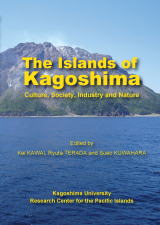| The Islands of Kagoshima |
| Edited by Kei KAWAI, Ryuta TERADA and Sueo KUWAHARA |
(If you would like to get this book, please contact to shimaken@cpi.kagoshima-u.ac.jp)
Preface
Environmental problems such as global warming and species invasion cause
global environmental change, which impacts the world’s ecosystems. Phenomena
such as economic and social problems are rapidly disseminated as seen in
the globalization of the world’s economies. Portions of the globe, which
can be quickly and easily influenced by such phenomena, are islands. The
islands of the Pacific demonstrate that rapid impact where rising sea levels
lead to country-wide crises.
An island is a small, simple model because islands are closed systems
isolated by water in a limited natural and human environment. Because islands
are so simple, a study of islands allows us to project the consequences
of fluctuating and complicated phenomena onto the larger world. An island,
therefore, is a site that can suggest a number of solutions to global problems.
Kagoshima is an island prefecture with the second largest number of islands
in Japan. The distance between north and south in Kagoshima is approximately
600 km. The islands in Kagoshima are primarily located in the sub-tropical
zone. Kagoshima Prefecture has 605 islands, which include 28 residential
islands. The Nansei Islands, which stretch southwest from Kagoshima to
Taiwan, were separated from the Eurasian continent due to sea-level rise
in the Neogene and then became islands. We could therefore say that these
islands have already been influenced by environmental changes, such as
sea level changes from global warming.
Islands from Okinawa to Kagoshima were called the Island of the Way,
and since ancient times, people and businesses have relocated to these
islands. Because the Amami Islands are located in the middle of the Island
of the Way, they have been influenced by Yamato culture from the north
and Ryukyu culture from the south. These islands have, therefore, experienced
another kind of globalization, migrating peoples, which are another important
factor impacting the world. Conservation of nature is essential to preserve
these beautiful and highly diversified natural environments and to protect
the native animal species, such as the Amami black rabbit, which inhabits
the Amami Islands. These islands are ideal sites for studying the impact
of globalization and environmental problems, and generating discussions
of possible solutions.
The Kagoshima University Research Center for the Pacific Islands (KURCPI)
published a book in 2001 entitled “Beyond Satsuma,” about the islands of
Kagoshima (http://cpi.kagoshima-u.ac.jp/project/projectindex.html). Ten
years have passed since that publication, and the economic and social system
on the Kagoshima Islands has changed. New evidence in a number of research
fields has been reported. The Project Planning Committee at KURCPI plans
to publish this new book in English to generate global awareness about
these remarkable islands.
To conclude, we would like to thank Project Planning Committee member
Sueo Kuwahara, Koji Aoyama, Satoru Nishimura, Ryuta Terada, Yositaka Sakamaki,
Sumie Nakatani, Kei Kawai, Kagoshima University, Kagoshima local government,
the public office on each island and local islanders for their support.
This book is the results of a research grant funded by 2011-2012 JSPS Grant-in-Aid
for Exploratory Research (No. 23651256 to KK).
Shinichi Noda
Director
Kagoshima University
Research Center for the Pacific Islands
 .jpg)
Culture and Society
- 1. Culture and Society in the Islands of Kagoshima
Sueo Kuwahara (pp.2-4) Download (PDF)
- 2. Research Issues in the Culture and Society of the Amami Islands
Sueo Kuwahara (pp.5-13) Download (PDF)
- 3. Amami Island Religion - Historical Dynamics of the Islanders’ Spirit -
Megumi Takarabe and Akira Nishimura (pp.14-20) Download (PDF)
- 4. The Educational Environment on a Remote Island in Kagoshima
Akio Hatta (pp.21-28) Download (PDF)
- 5. Cycads, Sustenance and Cultural Landscapes in the Amami Islands
Philip Hayward and Sueo Kuwahara (pp.29-37) Download (PDF)
- 6. Chili Peppers in the Islands of Kagoshima
Sota Yamamoto (pp.38-42) Download (PDF)
- 7. Health and Medical Issues and Longevity in the Amami Island Region
Toshiro Takezaki, Hideshi Niimura and Kazuyo Kuwabara (pp.43-47) Download
(PDF)
- 8. Environmental Hygiene in the Islands of Kagoshima
Shinichi Noda (pp.48-53) Download (PDF)
- 9. A Guide for the Study of Kinship and Social Organization in the Amami Islands
Sumie Nakatani (pp.54-58) Download (PDF)
- Column 1: Bullfighting on Tokunoshima Island
Takahiro Ozaki (pp.59-60) Download (PDF)
Industry
- 10. Economy in the Islands of Kagoshima
Satoru Nishimura (pp.62-66) Download (PDF)
- 11.The Amami Islands Promotion and Development Projects,
- and Socioeconomic Transformation
Takeichi Minamura (pp.67-72) Download (PDF)
- 12. Remote Islands Development Area in Kagoshima Prefecture
Shunsuke Nagashima (pp.73-77) Download (PDF)
- 13. Tourism Around the Kagoshima Prefecture Islands
Makoto Hagino (pp.78-83) Download (PDF)
- 14. Agriculture in the Islands of Kagoshima
-Special Reference to Fruit Production in the Yakushima and Amami Islands-
Shigeto Tominaga (pp.84-91) Download (PDF)
- 15. Significance of the Preservation of Crop Genetic Resources
in the Islands of Kagoshima
Michio Onjo (pp.92-94) Download (PDF)
- 16. Sugarcane Cultivation in the Islands of Kagoshima
Byoung-jae Park (pp.95-99) Download (PDF)
- 17. The Effect and Problems of Attracting Aquaculture Capital
- -A Case Study of the Koshiki Islands-
Takashi Torii (pp.100-106) Download (PDF)
- 18. Renewable Energy and Lifestyle Change
- -An Example of Yakushima Island’s “Zero Emissions” Initiative-
Hidetaka Ichikawa (pp.107-112) Download (PDF)
- Column 2: Edible Seaweeds in the Island Life
Ryuta Terada (pp.113-113) Download (PDF)
Nature
- 19. Nature in the Islands of Kagoshima
Kei Kawai (pp.116-117) Download (PDF)
- 20. The Kuroshio -Its Physical Aspect and Roles in Kagoshima’s
- Nature and Culture-
Hirohiko Nakamura (pp.118-127) Download (PDF)
- 21. Volcanic Island Chain South of Kyushu, Japan
Kisei Kinoshita and Masaya Sakamoto (pp.128-135) Download (PDF)
- 22. Biodiversity in the Islands of Kagoshima
Takahiro Okano (pp.136-145) Download (PDF)
- 23. A Review of Insect Fauna Reports for the Islands in Kagoshima Prefecture
Yositaka Sakamaki (pp.146-149) Download (PDF)
- Column 3: Vertebrate Fossils from the Islands
Hideo Nakaya (pp.150-150) Download (PDF)
Appendix (pp.151-158) Download (PDF)
-
(If you would like to get this book, please contact to shimaken@cpi.kagoshima-u.ac.jp)
|